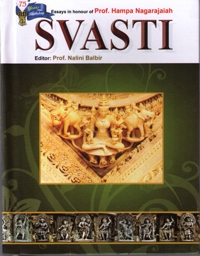21
Jaina Concept of Origin and Transmission of Speech (Bhāṣā)
Jaina scriptures often adopt a question-answer method for exposition of a subject. They treat speech (bhāṣā) in the same way. In the 11th chapter of the Paṇṇavaṇāsutta, questions about origin and transmission of speech (bhāṣā) are put by Gautama Gaṇadhara, to the Tīrthañkara Mahāvīra who answers them.
The questions are:
- Bhāṣā ṇaṃ bhante kimādīyā?
Where does the speech originate?
- Kiṃ pavahā?
From where is it produced?
- Kiṃ saṇṭhiyā?
What is it shaped like?
- Kiṃ pajjavasiyā?
Where does it come to an end?
The answers are:
- Bhāṣā ṇaṃ jīvādīyā.
Speech originates from jīva (soul)
- Sarīrappabhavā.
It is produced from the body.
- Vajjasaṇṭhiyā.
It is shaped as vajra, narrow in the middle and spread out at both the ends.
In Jaina metaphysics cosmos is supposed to be of this shape, roughly like that of a man standing akimbo with the legs wide apart.
- Loganta-pajjavasiyā.
It ends at the extremities of the cosmos, because there is no motion in the trans-cosmic space. Jīva, though the ultimate source of speech, can produce it when united with a body. The latter is acquired according to the Karman accompanying the jīva in its transmigratory course.There are eight main types of karman, viz.
- Jñānāvaraṇa, knowledge-obscuring,
- Darśanāvaraṇa, intuition-obscuring,
- Vedanīya, gender-determining,
- Mohanīya, deluding,
- Āyuṣka, lifespan-determining,
- Nāma, body-determining,
- Gotra, family-determining,
- Antarāya, obstruction-producing,
Ādyo jñāna-darśanāvaraṇa-vedanīya-mohanīya-āyuṣka-nāma-gotrāntarāyāḥ (Tattvārthasūtra 8.5).The body-determining (nāma-) karman consists of forty-two subtypes including gati: determining the course of a jīva through numerous forms of life as sura (divine), nara (human), nāraka (infernal) and tiryañca (sub-human);
jāti: determining the species;
śarīra: determining the shape and size of the body; Varṇa, gandha, rasa, phāsa, ātapa, uddyota etc., determining respectively colour, smell, taste, touch, heat and lustre etc. of the body;
svara: determining the type and quality of voice.Of the earthly jīvas thereare six categories, ṣaḍ-jīva-nikāya. These may be grouped as trasa (mobile) and sthāvara (immobile).
The latter consists of,
- Prithvī-kāya, earth-bodied,
- Apkāya, water-bodied,
- Tejas-kāya, fire-bodied,
- Vāyu-kāya, wind-bodied, and
- Vanaspati-kāya, plant-bodied,
All these are ekendriya (mono-sensed), having the sense of touch (sparśa) only.
- The trasas which constitute the sixth category, are:
- Dvīndriya, bi-sensed, having taste in addition, as earthworm;
- Trīndriya, tri-sensed, having smell in addition, as the ants;
- Caturindriya, tetra-sensed, having sight in addition, as the black bee; and,
- Pañcendriya, penta-sensed, having hearing in addition, as birds, animals and humans.
There are ten components of vitality (prāṇa), viz.
i) touch, ii) body, iii) respiration, iv) lifespan, v) taste, vi) speech, vii) smell, viii) sight, ix) hearing and x) ratiocination.
One-sensed beings have the first four components of vitality, viz. touch, body, respiration and lifespan; two-sensed have the fifth, taste, and the sixth, speech, in addition; three-sensed have the seventh, smell, in addition; the four-sensed have the eighth, sight, in addition; and the five-sensed beings have the ninth, hearing, in addition. But among these ratiocination remains the exclusive preserve of the five-sensed rational beings, namely, the humans.
In Jaina metaphysics bhāṣā or vāc has been postulated as paudgalika (non-sentient matter and energy). Only an embodied jīva can produce it by vibrating its appropriate paudgalika contentto express its agreeable or disagreeable feeling (sātāsātā-vedanā). Since the sthāvaras (immobile) cannot vibrate their paudgalika content, these have no speech, though they are jīva and have a body also. Only the trasas, two-sensed onwards, can do that. But in their case too bhāṣā or vāc need not be invariably vocal. Any physical movement of a jīva, under the impact of a sensation, gross or subtle, is expressive of its response, and, is, therefore, speech, oral or extra-oral, audible or inaudible.
In physical observation, two-sensed like worms etc., three-sensed like ants etc. do not seem to be producing any sound. But on minute observation, it has been found that insects produce sound by friction, the ants and the like by vibrating their proboscis. The snakes produce hissing sound by short quick breath, the crickets by vibrating their external membrane and the black bees by vibrating their wings. Fishes produce sound by vibrating the inner muscles of their body. Animals and birds produce vocal sound. All these sounds are inarticulate. Articulation begins with the humans who, besides the five senses, have a ratiocinative mind by virtue of which they can conceptualize their percepts and find out ways to express the concepts by producing appropriate sounds.
Speech when emitted, instantly assumes a vajra- shape, i.e. the shape of the cosmos, at the extremities of which it terminates, because motion is not possible in trans-cosmic space. Speech, as sound waves, is mechanical energy which is transmitted by compression waves, at different speed in different media like air, water, metal etc. This speed is much less than that of light (roughly three lakh kilometer per second). So speed consisting of sound waves, instantly touching the extremities of the cosmos is an impossibility. Since speech has its origin in the jīva, it basically consists of spiritual vibrations which can traverse and pervade the cosmos instantly [cf. nāda-brahma, omnipervasive voice]. Though the jīva, rid of karmic hindrances, as it is in case of an omniscient, can know and see the transcosmic space (aloka) also, its spiritual vibrations have to be limited within the cosmos, beyond which motion is not possible.
From the spiritual state speech comes to the physical level. It is here that its objects are perceived and conceptualized in terms of language and uttered. The spiritual and different physical stages are comparable with parā, paśyantī, madhyamā and vaikharī stages of vāṇī. At the spiritual stage it is parā; while perceiving the object to be expressed, it is paśyantī, while transforming the object (artha) into speech-sounds it is madhyamā, at the utterance stage it is vaikharī.
Now, the question arises: how long does it take for a concept to be encased in word and delivered, ‘katihi va samayehi bhāsati bhāsaṃ’, how many samayas, instants, (the smallest unit of time), does the jīva take in conceiving and delivering speech? The answer is, ‘two samayas, instants’. Since, there can’t be delivery without conception, so in the first instant the jīva conceives and in the second it delivers. In continuous speech, in the second instant, the jīva while delivering the first particle of speech, conceives the next, till the last instant in which there is delivery and no further conception. Practically, the processes are simultaneous, but then conception has to precede delivery in order. The speaker may go on conceiving the speech-matter and retain it in memory for delivery at some later time, with a gap of two to innumerable samayas,instants.
This process of conceiving and delivering is called grahaṇa-nissaraṇa. In the process of grahaṇa, the entire self of the speaker - mind, body and senses, are in action. In the nissaraṇa, however, it is only the vocal organ which is in action, of course along with the mind.
This apparently two-phased action of grahaṇa and nissaraṇa, is actually three-phased. The initial phase is identification of the matter to be expressed through speech, bhāṣā-dravya. It is to be followed by its conversion into speech-language, bhāṣātvena pariṇamana. This is the inner linguistic expression of the matter which is of necessity interwoven with the process of identification of the matter to be expressed by means of speech-language. It is a link between the grahaṇa, the initial stage, and nissaraṇa the final utterance.
Any object of knowledge may constitute the content of speech (bhāṣādravya) provided that
- it is present (sthita) before the senses and mind of the speaker;
- it is in full contact of the speaker jīva; in other words the speaker jīva is pre-occupied with it;
- the speaker jīva is competent to express it.
Five types of exposition of a subject matter have been identified-
Conclusion:
- Speech (bhāṣā) originates in the soul.
- It is expressed through the body.
- At the spiritual level its transmission is instantaneous.
- It terminates at the end of the cosmos because in the trans-cosmic space there is no motion.
- Its physical expression varies with the number of the senses of the jīvas.
- It remains mute in the mono-sensed jīva—Earth, Water, Air, Fire and Plant.
- It is expressed in two-, three-, four-, and five-sensed Jīvas.
- In sub-humans it is inarticulate.
- Humans, because of their having a rational mind, can raise it to articulate level.
- Articulation varies from person to person according to the individual’s capacity to conceive and deliver the speech-matter (bhāṣā-dravya).
 Prof. Dr. Ramprakash Poddar
Prof. Dr. Ramprakash Poddar
